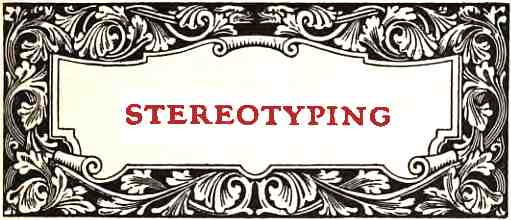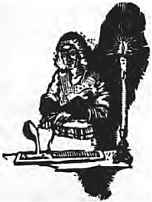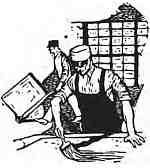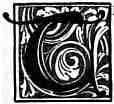
 BOUT
the beginning of the eighteenth century, a certain Van der Meyer, of
Antwerp, made the next step towards a definite improvement in
typography, the first that had been attempted since the invention of
printing from movable, cast-metal type.Van der Meyer prepared the
composed pages of the Bible by soldering together the bottom of the
type in the form. This was the first "stereotype," a term derived from
two Greek words meaning literally "solidtype."
BOUT
the beginning of the eighteenth century, a certain Van der Meyer, of
Antwerp, made the next step towards a definite improvement in
typography, the first that had been attempted since the invention of
printing from movable, cast-metal type.Van der Meyer prepared the
composed pages of the Bible by soldering together the bottom of the
type in the form. This was the first "stereotype," a term derived from
two Greek words meaning literally "solidtype."This method met one requirement. It prevented the "pi-ing" of the type, but it had the disadvantage of holding in comparative idleness a large and costly mass of type useless for any other purpose, and it was not generally practiced.
This was followed in 1730, by William Ged, a goldsmith of Edinburgh, who is credited with casting printing plates in plaster-of-paris molds for the University of Cambridge Bible. These plates, however, were destroyed by jealous printers and thrown aside, resulting in the process being abandoned for many years.
In the meantime, several other improvements along this line were undergoing experiment. Firmin Didot, (1764-1836), a printer of Paris, cast type of a hard [p.18] alloy, and when his book-pages were composed, made an impression of them on a sheet of soft lead, thus forming a mold. Molten metal was then poured into a shallow tray, and just as this was on the point of solidifying, but still plastic, the lead-mold of the book-page was pressed on the soft metal in the tray. This process called Polytypage, was but partly successful; it could be used only for small pages, and the plates were too often defective. A process similar to this is what Lambinet thought the printers of the latter half of the fifteenth century might have used as one of the probable methods to cast their metal types.
These and other experiments, however, were leading to the real stereotyping process which developed later. Early in the nineteenth century, Earl Stanhope, of England, re-introduced Ged's stereotyping process with many improvements.
One or more pages of type were locked in a chase, the surface of the type being oiled to prevent the subsequent mold from sticking. The mold was made by pouring a semi-fluid composition of plaster-of-paris mixed with a little fine salt to make the plaster settle solidly. While the plaster was still soft, it was carefully pressed down and rolled smooth on top to give a uniform thickness to the mold and to expel any air there might be in the plaster. When the plaster became solid, it formed a perfect matrix of the type pages.
The moisture in those early plaster molds was expelled by baking them in an oven for three or four hours. A later method for drying was practiced by suspending the mold directly over the metal-pots or to float them on the surface of the molten metal. By this [p.19] means the drying could be accomplished in a half-hour or so.
 In the process of
casting, several of these plaster molds were placed side by side face
downward in a special casting-pan. The pan was one and three-quarters
or two inches deep, and a lid on the pan screwed down on the back of
the molds. By means of a crane the casting pan with its molds was then
lowered into the pot of molten metal which ran into the pan at the
corners and sides. The mold was allowed to remain ten minutes or so in
the metal-pot, or until the face of the inverted mold was entirely
filled with the metal.
In the process of
casting, several of these plaster molds were placed side by side face
downward in a special casting-pan. The pan was one and three-quarters
or two inches deep, and a lid on the pan screwed down on the back of
the molds. By means of a crane the casting pan with its molds was then
lowered into the pot of molten metal which ran into the pan at the
corners and sides. The mold was allowed to remain ten minutes or so in
the metal-pot, or until the face of the inverted mold was entirely
filled with the metal.A later method of casting from a plaster mold was to place it in a frame with a smooth, flat plate opposite the face of the mold and to enclose the open space at one end and on the two sides. The casting space thus formed was then turned with the open end up and metal was poured in with a ladle, in a manner similar to the method still employed for casting job-work stereotypes. The distance between the flat plate and the mold was adjusted to make a stereotype plate of the required thickness.
After the removal and cooling of the casting pan, the plates were freed from the plaster and the surplus metal cut off. Only one cast could be made, as the mold was usually destroyed in removing the cast. The stereotype was then sent to the finishing department, where the [p.20] face was cleaned and examined for defective letters, then trimmed on the sides and planed off uniformly on the back to the desired thickness, in the same manner as a stereotype is treated today. A defective letter could be mortised out of the plate and a good type inserted in its place. In cases where a whole line or other part was imperfect, another mold was made of as much of the form as was necessary and the new cast inserted and soldered to the plate.
There were many and varied experiments made in the earlier development of this idea of producing a duplicate printing form in a single piece. That such a process was highly desirable was universally recognized, and the conviction that some practicable and economical method was feasible was a continual incentive which gradually led to better results.
[p.21]


 LTHOUGH
credit is given to John Watts, an Englishman then working in America,
for making the first stereotype plates here, the real introduction of
the process to the United States was by David Bruce. This was in 1813.
Bruce had learned the printer's trade in Edinburgh and later came to
America, where after a few years he was joined by his brother George in
establishing the firm of D. & G. Bruce, printers. Hearing of the
new process of stereotyping in England, he went over there to learn
about it. He could get very little information about the process
there, but came back with some practical ideas which he proceeded to
carry out. Bruce and his brother also began type-founding about this
time, and abandoned the business of printing. Later they gave up the
work of stereotyping.
LTHOUGH
credit is given to John Watts, an Englishman then working in America,
for making the first stereotype plates here, the real introduction of
the process to the United States was by David Bruce. This was in 1813.
Bruce had learned the printer's trade in Edinburgh and later came to
America, where after a few years he was joined by his brother George in
establishing the firm of D. & G. Bruce, printers. Hearing of the
new process of stereotyping in England, he went over there to learn
about it. He could get very little information about the process
there, but came back with some practical ideas which he proceeded to
carry out. Bruce and his brother also began type-founding about this
time, and abandoned the business of printing. Later they gave up the
work of stereotyping. The first book stereotyped in the United States was the New Testament, in 1814. Bibles and school books were the first works to be stereotyped; then came other books which were demanded in many editions, such as the works of popular authors.

 HE
papier-mache (literally, mashed paper matrix was
first successfully used casting stereotypes for book pages France in
1848. Charles Craske, an engraver of New York, introduced the method
into the stereotype trade of the United States in 1850, and in 1854 he
stereotyped a page of the "New York Herald" and later made stereotypes
for other New York newspapers.
HE
papier-mache (literally, mashed paper matrix was
first successfully used casting stereotypes for book pages France in
1848. Charles Craske, an engraver of New York, introduced the method
into the stereotype trade of the United States in 1850, and in 1854 he
stereotyped a page of the "New York Herald" and later made stereotypes
for other New York newspapers.